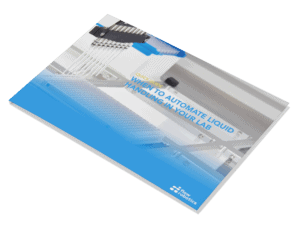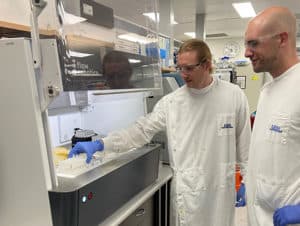Hebrew University
Microbial communities created with flowbot® ONE
In the Friedman Lab at Hebrew University in Jerusalem, a group of researchers study how microbial communities form, function, and evolve. Their pipetting partner is none other than the flowbot® ONE.
PhD student Nittay Meroz uses the flowbot® ONE for creating different microbial communities by normalizing and assembling bacterial species. He will subsequently grow the communities and analyze their evolution.

One experiment can have 120 different community combinations. Mixing them requires a lot of pipetting. We use flowbot® ONE successfully for that. We also use it to normalize them because they reach different concentration levels.
Book a free demo
Do you also want to see if we can help you – Book a customized 30 min. demo that fit your lab needs and find out
High reproducibility and low error-rate
Automating the process ensures high reproducibility and a low error-rate.
“I used to assemble the communities manually but that could easily lead to errors. The combination is different for each experiment, and it takes a lot of concentration to keep track of everything. It is mentally tiresome, and it takes time. With the flowbot® ONE, the experiment is not dependent on my pipetting technique and memory,” he says.
Nittay Meroz finds it’s easier to design his protocol on the flowbot® ONE than by hand.
“When I did it manually, I had to find creative ways of designing the protocol to remember where things were located. But with the flowbot I don’t need to think about it at all. It’s great because I already have plenty of other things to think about,” he laughs and adds:
“I think it’s also more accurate as well and more reproducible because I can use the exact same program.”
Working with CSV files
Nittay Meroz works with CSV files in the flowbot® ONE instead of programming in the software. This made it a breeze to implement the robot into his workflow.
“I have a python script, so I just upload the CSV file in the flowbot® ONE software. I don’t know what I would do without the CSV file function. Creating the program is very easy and the software is user-friendly and nice to work with. And Flow Robotics’ service is very good if I need anything else.”
There are up to 5 different projects in the lab, all assembling synthetic communities with the flowbot® ONE.

Using flowbot® ONE has allowed the entire lab to scale up because we can do other things simultaneously and don’t need to repeat experiments due to potential mistakes.
Want more information?
Fill in the form and let’s talk
About the Department of Plant Pathology and Microbiology, Hebrew University
The Department of plant pathology and Microbiology aims at discovering, understanding, and applying novel principles and approaches to improve agriculture along with improving the environment. This challenge is addressed through theory, experiments, and field studies, and teaching basic courses to advanced classes.
The department hosts Israeli as well as international graduate students and post-doctoral fellows.
Learn more
Do you want to explore the flowbot® ONE further? Then we suggest to look at:



